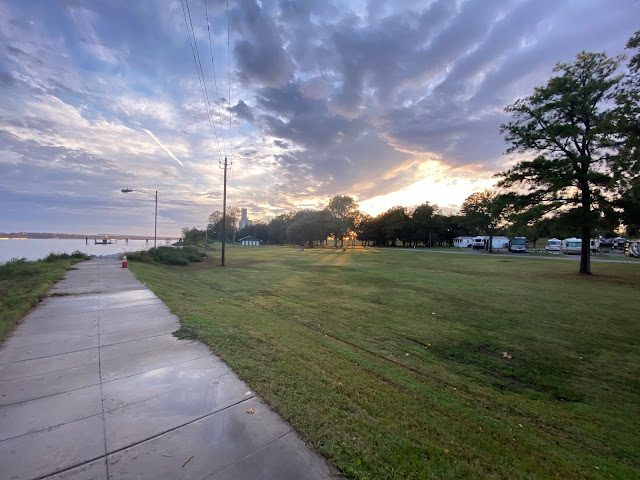Today we drove about 15 miles west of Vidalia to a little town named Ferriday. We spent approximately six hours in and around a town with a population of only 3500. We drove to Frogmore Plantation but a tour bus had just pulled into the parking lot so we were told that it would be better to return to Ferriday and tour the Delta Music Museum and return after a couple of hours. So that is what we did. We visited the museum and had lunch.
 |
| The Delta Museum features many singers from what they call "the delta area." Of course, the most famous are these three: Mickey Gilley, Jerry Lee Lewis, and Jimmy Swaggart. Some of the others were Fats Domino, Johnny Horton, Aaron Neville, The Hemphills, and Conway Twitty. |
 |
| The picture above and below show that the museum was once the Ferriday Post Office. |
 |
| The postmaster had a nice office. |
 |
| We happened upon this street sign. I sure the other two more famous singers had streets named after them too. |
 |
| We ate lunch at Big Bob's BBQ. |
 |
| Carol had fish, fries, and a salad. It came with brown gravy to dip his fries in. The gravy must be a southern thing. |
After lunch we returned to Frogmore Cotton Plantation which was established in 1815 by a man named Daniel Morris. He admired the English royal family and named it after the Frogmore estate which is a part of Home Park in Windsor, England. During the Civil War the plantation had approximately 800 enslaved people. The current owner of Frogmore was a kind man and treated the enslaved people very well. Today several descendants of the original enslaved people still work on the farm.
 |
| This old general store was moved to the plantation by the current owners, the Tanners. They are not only farming the land but trying to set up the area we were as historically correct for the 1800's. Most of the buildings we were in are original but not original to Frogmore. Mrs. Tanner lived in Monticello, Illinois as a little girl. |
 |
| In this building we learned how cotton was ginned. An enslaved person could pick 10 acres of cotton during the cotton growing season of September-November. The cotton plant would be picked four times during during that season. The picker could carry 70 pounds of cotton before emptying it into a sided-wagon along with what others were picking. Picking was done sunup to sunset |
 |
| This tree is called a "turkey pine." |
 |
| The first bloom on the cotton plant is white and it is white for only 24 hours. |
 |
After 24 hours, the bloom turns pink and remains pink for another 24 hours before the cotton boll begins to form. It is 45 days from first planting the seed until it can be harvested.
In 1897 boll weevils came into the United States from Mexico. It only took them five years to completely wreck havoc cotton crops. It wasn't until 2005 that boll weevils were completed eliminated from the United States.
The lady doing the tour was so interesting and had some many facts that my brain went into overload. The tour lasted about two hours. You could tell that she knew the history of Frogmore and cotton and wanted to share it with us.
|
 |
| When we got back to camp, the sun was shining so I took a couple of pictures from the side window of the motorhome so I could remember the view from our camper. |
 |
| After these pictures were taken, the sky filled with storm clouds and it rained and the winds blew. I had hopes of sitting on the levee and taking beautiful pictures. Finally, the rains and winds stopped and the clouds began to break up. I was able to take a few pictures. |
 |
| We had a great day learning about cotton plantations and the musical talent that comes from the Delta area. We have the car loaded so tomorrow we can be on the road early. We only have a little over 300 miles to Terrell, Texas just outside of Dallas. Texas, here we come! |




















































